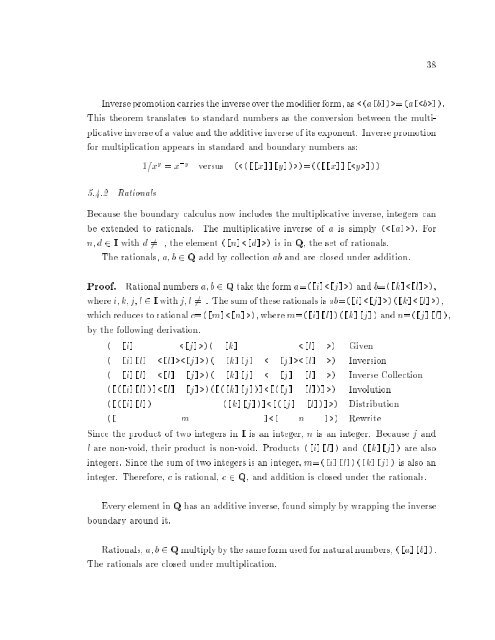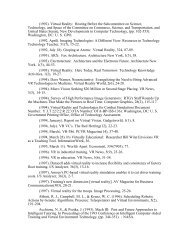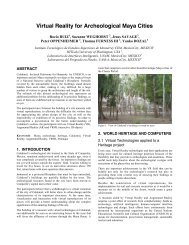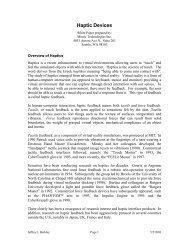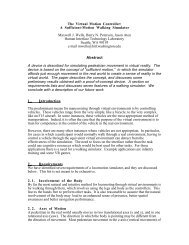A Calculus of Number Based on Spatial Forms - University of ...
A Calculus of Number Based on Spatial Forms - University of ...
A Calculus of Number Based on Spatial Forms - University of ...
You also want an ePaper? Increase the reach of your titles
YUMPU automatically turns print PDFs into web optimized ePapers that Google loves.
38<br />
Inverse promoti<strong>on</strong> carries the inverse over the modier form, as =(a[]):<br />
This theorem translates to standard numbers as the c<strong>on</strong>versi<strong>on</strong> between the multiplicativeinverse<br />
<str<strong>on</strong>g>of</str<strong>on</strong>g> a value and the additiveinverse <str<strong>on</strong>g>of</str<strong>on</strong>g> its exp<strong>on</strong>ent. Inverse promoti<strong>on</strong><br />
for multiplicati<strong>on</strong> appears in standard and boundary numbers as:<br />
1=x y = x ,y versus ()=(([[x]][]))<br />
5.4.2 Rati<strong>on</strong>als<br />
Because the boundary calculus now includes the multiplicative inverse, integers can<br />
be extended to rati<strong>on</strong>als. The multiplicative inverse <str<strong>on</strong>g>of</str<strong>on</strong>g> a is simply (): For<br />
n; d 2 I with d 6= , the element ([n]) is in Q, the set <str<strong>on</strong>g>of</str<strong>on</strong>g> rati<strong>on</strong>als.<br />
The rati<strong>on</strong>als, a; b 2 Q add by collecti<strong>on</strong> ab and are closed under additi<strong>on</strong>.<br />
Pro<str<strong>on</strong>g>of</str<strong>on</strong>g>.<br />
Rati<strong>on</strong>al numbers a; b 2 Q take the form a=([i]) and b=([k]);<br />
where i; k; j; l 2 I with j; l 6= . The sum <str<strong>on</strong>g>of</str<strong>on</strong>g> these rati<strong>on</strong>als is ab=([i])([k]);<br />
which reduces to rati<strong>on</strong>al c=([m]); where m=([i][l])([k][j]) and n=([j][l]);<br />
by the following derivati<strong>on</strong>.<br />
( [i] )( [k] ) Given<br />
( [i][l] )( [k][j] < [j]>) Inversi<strong>on</strong><br />
( [i][l] )( [k][j] < [j] [l] >) Inverse Collecti<strong>on</strong><br />
([([i][l])])([([k][j])]) Involuti<strong>on</strong><br />
([([i][l]) ([k][j])]) Distributi<strong>on</strong><br />
([ m ]) Rewrite<br />
Since the product <str<strong>on</strong>g>of</str<strong>on</strong>g> two integers in I is an integer, n is an integer. Because j and<br />
l are n<strong>on</strong>-void, their product is n<strong>on</strong>-void. Products ([i][l]) and ([k][j]) are also<br />
integers. Since the sum <str<strong>on</strong>g>of</str<strong>on</strong>g> two integers is an integer, m=([i][l])([k][j]) is also an<br />
integer. Therefore, c is rati<strong>on</strong>al, c 2 Q, and additi<strong>on</strong> is closed under the rati<strong>on</strong>als.<br />
Every elementinQhas an additiveinverse, found simply by wrapping the inverse<br />
boundary around it.<br />
Rati<strong>on</strong>als, a; b 2 Q multiply by the same form used for natural numbers, ([a][b]):<br />
The rati<strong>on</strong>als are closed under multiplicati<strong>on</strong>.


